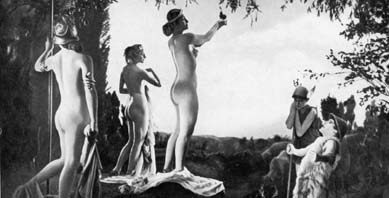The Kulturfilm
"War is father of all" – Nicholas Kaufmann took this classic quote as his slogan when, in a festschrift, he looked back on the 25-year history of Ufa's Kulturfilm department, which he directed. The department commenced its work in the final months of the First World War, and by spring 1919 it had sent out a catalogue of 87 Kulturfilme (a specifically German film genre closely related to today's documentary). The foreword reads: "The wounds of war can only be healed if we devote ourselves to the tasks of humanity." The movies dealt with a variety of subjects, including war-related health problems caused by years of malnutrition and by sexually transmitted diseases. From the start, the department collaborated with university and clinic doctors, and many of its movies were conceived as educational films for medical training. Labor pains, appendectomies, bacteriological experiments and surgical procedures – Ufa showed it all. Its technicians developed a special piece of equipment and installed it in a Berlin hospital: a camera suspended directly above the operating table, which surgeons operated via a foot switch (with aseptic conditions guaranteed, as was assured). Film was still controversial as an art form, but it was immediately embraced as a valid tool of science. Rare diseases and complicated treatment procedures could now be documented on celluloid. The medical film archive of Ufa's Cultural Department held 135 educational films after just five years, and it was systematically expanded. This line of business enjoyed great commercial success: Ufa – which cooperated with public authorities and was represented at international medical conferences – sold its Kulturfilme to universities in Germany and abroad, where they were incorporated into the curricula.

More promotional effort was required to establish the Kulturfilm in schools. Ufa representatives traveled across the country with sample films, organizing screenings for secondary school teachers, school principals, and city dignitaries. Ufa even showed its films to the Weimar National Assembly. It was eventually successful with politicians: under a regulation passed at the time, the screening of Kulturfilme of a special grade provided cinema owners with tax benefits. Popular science adaptations of these school and educational films – produced in the Kulturfilm studio in Berlin-Steglitz – were soon supplementing the main films on cinema programs. Animal, nature and travel films predominated, and the first movie of this kind was "Der Hirschkäfer" (The Stag Beetle), which premiered at the Tauentzien-Palast, one of Ufa's own theaters, in 1921.Three years later, UFA took on the more daring task of producing a feature-length Kulturfilm. The experiment proved a success, and films like "Wein, Weib, Gesang" (Wine, Women, Song, 1924), about grape-growing and wine-making, and "Des Menschen Freund" (Man’s Best Friend, 1924), about dog breeds and dog-breeding, drew audiences to cinemas. The movie that broke all box office records was "Wege zu Kraft und Schönheit" (Ways to Strength and Beauty), which, premiering in 1925, promoted a "modern body culture." The production consciously forged links with the past, showing scenes of athletic games that recalled the cultural ideal of classical antiquity and the harmony between (the naked) body and spirit. Both principles were portrayed as part of a stereotypical ideal of beauty. Nicholas Kaufmann, who co-directed the film with Wilhelm Prager, explained that the production was "based on the clear recognition that, after disbanding the army, people in Germany have good reason to compensate for the loss of the valuable training given to male youth during their military service – and, beyond this, to encourage female youth, through ideal images of a strong, beautiful mankind, to train their bodies."